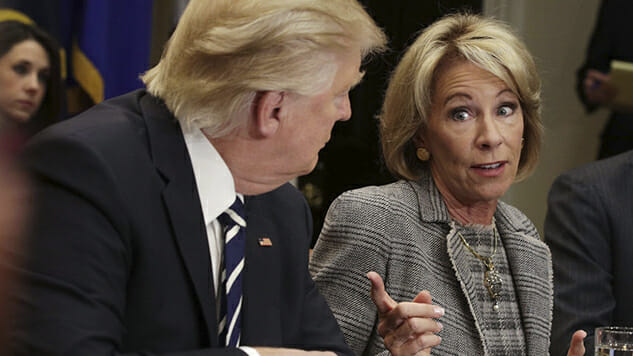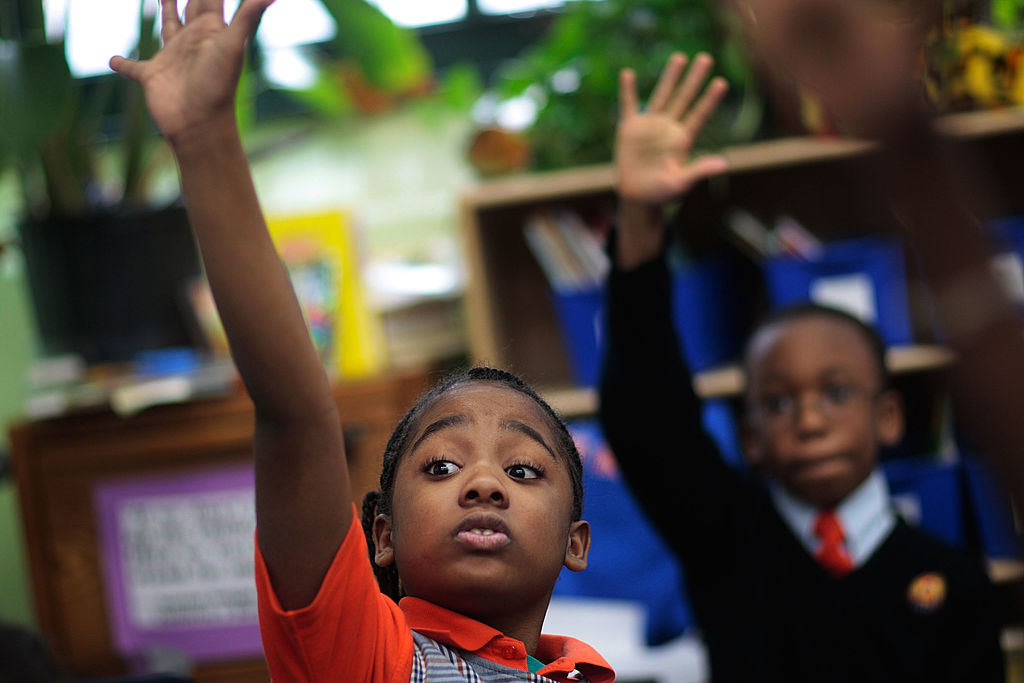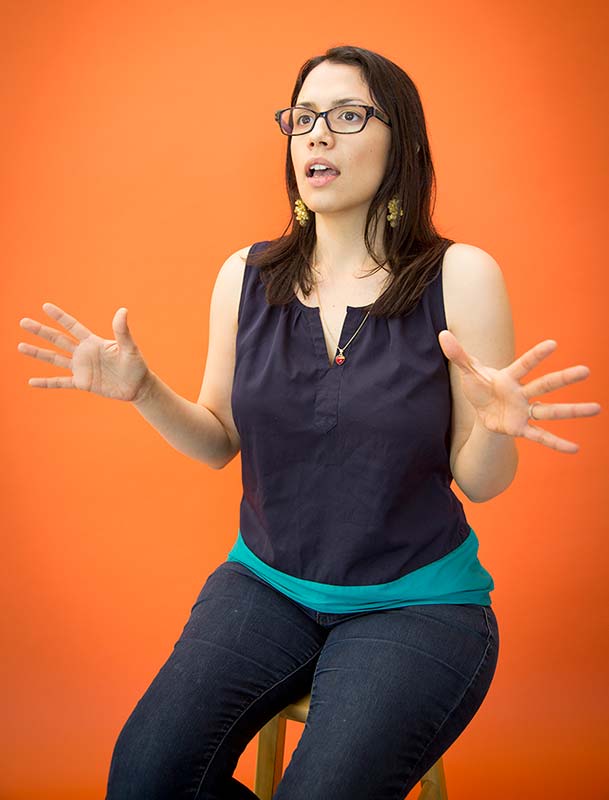As Betsy Devos Whitewashes HBCUs and Trump Plans to Defund the NEA, We Need to Rethink How We Teach Kids About Art
Photos courtesy of Nikkolas Smith, Leroy Hamilton, Nathalie Sanchez and Getty Images/Chris Hondros and Alex Wong
With the Trump administration threatening to defund comprehensive arts education programs and an education secretary who confusing school segregation for school choice it’s hard not to become utterly depressed at the very mention of our nation’s education system.
As curricula fall prey to de-liberalization under the direction of the barely-confirmed, keep-God-in-our-schools preaching Betsy DeVos, we must take a deeper look at the responsibility of our educators to intervene. While xenophobia has begun to permeate our culture, a new wave of artistic resistance has been awakened. Teaching that resistance, though, is the often overlooked instrumental first step in mobilizing a new generation of artistic activism.

For Associate Professor and Director of the Graduate Art + Education Programs at NYU Steinhardt, Dipti Desai, it’s not just about using art to represent these issues, but going a step further and acting on them. “Picasso’s Guernica will certainly move a number of people, but it might not necessarily move them to take real action,” said Desai. “Even if they don’t come from an activist background, our students are usually seeking to understand and intervene in the world, using the arts as a form of social activism. As opposed to just sitting and doing a still life for four hours, young people are really responsive to this type of education.”
Desai, whose parents and grandfather were freedom fighters in India, is one of the many educators confronting the influxes of students of color and women entering still largely Eurocentric arts education programs. The problem with this is that the arts have historically been a source of empowerment for disenfranchised communities. By this definition, “art history” should look more like a series of histories, inspired by different experiences. In today’s political climate though, despite GOP motions to turn our classrooms into artless ‘havens’ from the cruel outside world, we cannot ignore the power of art in representing our varied situations.
“Having taught at almost every grade-level at this point, the majority of people that I’ve served are people of color…by far,” said Los Angeles artist and arts educator, Nathalie Sánchez, “The problem is we try to present lesson plans made up almost entirely of master works by dead, white males.” Sounds almost as messed up and misguided as the way American History is taught in our schools, no? The problem with teaching history is that there are many “histories” that compose the whole story of America, and the same can and should be said for Art History.
Sánchez, who’s worked with every student demographic from kindergarteners to museum professionals, began her own arts education as a student at Loyola Marymount University where she worked alongside legendary Chicana artists and activists like Barbara Carrasco, Dolores Huerta, and Rigoberta Mechú. But as a Latin American whose personal art history had been shaped by the early Mexican muralists and the Chicano Art Renaissance, Sánchez had to take a self-guided approach with her own studio arts education.
In fact, the mural class wherein Sánchez worked with these three influential workers’ movement leaders, wasn’t an art class at all, but a class in the school’s Chicano Studies department. “I felt the responsibility to be vocal, to ask, why wouldn’t this be a studio arts course? Because from where I stood I could see the devaluation of murals and the mural movement as a whole as a legitimate art medium, but I also saw them identifying murals as strictly working within this category of Latino art. It was like this “other” that wasn’t viewed as “art” in the context of a classical studio arts education.”
“The problem is we try to present lesson plans made up almost entirely of master works by dead, white males.”
Sánchez’s story is not unique. Many women and persons of color feel underrepresented even in the most liberally-minded professional fields. As with American History, the rubric for teaching Art and Art History will not change overnight. And even as it does change, do we really expect it to shift totally in favor of a totally inclusive perspective? How can we accomplish such an undertaking?
We need to diversify the actual artistic content included in our school and university lesson plans, but we also need to teach that art itself is and can be a movement against injustice and marginalization of entire communities of people. Despite the agonizing jeers from those who can’t seem to wrap their heads around why on earth an artist would speak out against injustice, there is no denying that imagery and artistic expression have and will continue to influence public opinion.
There is arguably no greater example of a modern movement presenting alternative histories and using imagery to bring about change than Black Lives Matter. Following the deaths of Trayvon Martin and Michael Brown, we saw images like Nikkolas Smith’s powerful image of Martin Luther King, Jr. in a hoodie or Nina Chanel Abney’s abstract depictions of police brutality. And to this day, chapters of Black Lives Matter around the country are facilitating art shows and public performances, proclaiming their humanity through the arts.
L.A. artist and original member of Black Lives Matter Funmilola Fagbamila told Paste: “As I see it, art coming out of black communities has never really had the luxury of simply existing for the purpose of enjoyment or aesthetic. It has always and forever will be tied to a direr need to uphold the complexity of our humanity, to affirm the urgency of social change in addressing anti-blackness.”
The Activist-in-Residence at the Institute on Inequality at UCLA Luskin and long-time arts and culture director of Black Lives Matter Los Angeles did not study art formally, but used art as an outlet for her work in Sociology and Black and Pan-African Studies. Fagbamila’s own performance art pieces are undoubtedly products of her own diverse educational background. In her most recent project, The Intersection: A Play About Woke Black Folk she explores the complexities of black identity. It’s her ability to communicate the intricacies of injustice through art that Fagbamila translates so effortlessly to the classroom. Whether teaching gender studies and sexuality, prison culture and mass incarceration of people of color, or police brutality, Fagbamila employs the universal language of artistry to capture her students. “There’s just a certain way that they respond to art—it hits a different nerve.”
It’s time to teach art as a social practice. Our educators have a duty to prepare the next generation of creatives for the road ahead, but they also must prepare them for the here and now. Students must understand a variety of global perspectives that look nothing like Trump’s whitewashed America or Betsy DeVos’ “Jesus school.” Art must be communicated as it really is—an astounding weaving of narratives and one of the most powerful tools in the fight against injustice.
@leahrosenzweig is a regular Paste contributor.
